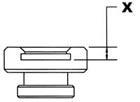bigedp51
Well-Known Member
- Joined
- Dec 10, 2010
- Messages
- 1,022
Thanks to everyone for helping me out with this one. Seeing as how the newer brass resized properly, I don't think there is an issue with the die or shell holder, (although I am going to purchase the die kit that Dusty noggin posted). I am convinced now that I need to learn how to properly anneal brass. I will move questions with that to a new thread. Thanks again....
If you buy the Redding competition shell holders that Dusty Noggin advised you will make your problem worse. These shell holders are like placing a .002, .004, .006, .008 or .010 feeler gauge between the bottom of the die and the shell holder. Meaning you will have "LESS" shoulder bump than with a normal shell holder.

Competition Shellholder Sets
Now you can control headspace. The new Redding Competition Shellholders are packaged in five piece sets in .002" increments (+.002", +.004". +.006", +.008" and +.010"). Each shellholder has a distinct black oxide finish and is clearly marked to indicate the amount it will decrease case-to-chamber headspace. You can now easily adjust the shoulder bump to customize cases to your specific chamber.. The new Redding Competition Shellholders are packaged in five piece sets in .002" increments (+.002", +.004". +.006", +.008" and +.010"). Each shellholder has a distinct black oxide finish and is clearly marked to indicate the amount it will decrease case-to-chamber headspace. You can now easily adjust the shoulder bump to customize cases to your specific chamber.


